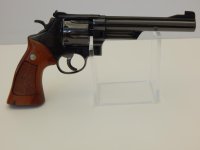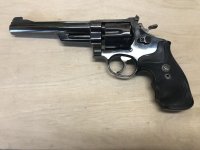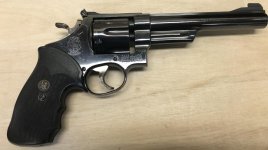I think my question belongs in smithing but I'm also in need of a tutorial of how to use the search function of the SWCA Forum.
I've posted my Model 25-2 before and have found out that although I have a Factory Letter decribing how it left the factory, I've since found out (because of the aftermarket double ball detent yoke lock) that it had been setup for competition by the previous owner. Then I was made aware of lightened mainspring, polished internals, shortened rebound slide spring...all resulting in a sweet to shoot light SA & DA trigger pulls.
Anyway....I am going to be selling this one again soon, only this time I will offer with all factory parts, including stocks, as well as all the competition parts. Everything has been posted and commented on by a good number of the knowledgeable experts here on the Forum so the only thing left is the throat diameter. I recall seeing posts (probably years back) about how this Model 25-2 had notoriously large cylinder throat diameters direct from the factory and of course this would affect accuracy.
I cannot find ANY of those old posts and it is probably me not really knowing how the "advanced search" function works. I tried different search terms, different forums, but nothing comes up for me. Is there a sticky for the search option somewhere on the Forum?
For you folks that know this stuff I looked at my copy of SAAMI and for 45ACP FMJ the bullet is .4520" - .0030", and for lead .4530" - .0030".
Next I removed the cylinder and yoke from my gun, aligned cylinder vertically up (throats facing up) and used my Mitutoyo Digital Calipers for measuring each cylinder. With the first throat at 12 o'clock I inserted the zeroed caliper approx 1/4" and thumb wheel expanded till I felt 'mike drag", locked, and removed for reading. Rotate cylinder counterclockwise, repeat all above for "throat 2" through "throat 6.
Results: Throats 1, 3, and 5 measure .4540"; throats 2, 4 and 6 measure .4535. No throats are oblong.
I've also seen an article by Grant Cunningham stating that the only true way to measure throats is with pin gauges, but with this I would need a large set to cover all the possibilities that he mentions being off as much as .003" either way.
In you folks very valued opinion...do I need to worry about oversize throats at .454?? I'm not shooting any competition but I want to list it as fair and as accurate as I can.
Any help is greatly appreciated. Thanks for listening.
I've posted my Model 25-2 before and have found out that although I have a Factory Letter decribing how it left the factory, I've since found out (because of the aftermarket double ball detent yoke lock) that it had been setup for competition by the previous owner. Then I was made aware of lightened mainspring, polished internals, shortened rebound slide spring...all resulting in a sweet to shoot light SA & DA trigger pulls.
Anyway....I am going to be selling this one again soon, only this time I will offer with all factory parts, including stocks, as well as all the competition parts. Everything has been posted and commented on by a good number of the knowledgeable experts here on the Forum so the only thing left is the throat diameter. I recall seeing posts (probably years back) about how this Model 25-2 had notoriously large cylinder throat diameters direct from the factory and of course this would affect accuracy.
I cannot find ANY of those old posts and it is probably me not really knowing how the "advanced search" function works. I tried different search terms, different forums, but nothing comes up for me. Is there a sticky for the search option somewhere on the Forum?
For you folks that know this stuff I looked at my copy of SAAMI and for 45ACP FMJ the bullet is .4520" - .0030", and for lead .4530" - .0030".
Next I removed the cylinder and yoke from my gun, aligned cylinder vertically up (throats facing up) and used my Mitutoyo Digital Calipers for measuring each cylinder. With the first throat at 12 o'clock I inserted the zeroed caliper approx 1/4" and thumb wheel expanded till I felt 'mike drag", locked, and removed for reading. Rotate cylinder counterclockwise, repeat all above for "throat 2" through "throat 6.
Results: Throats 1, 3, and 5 measure .4540"; throats 2, 4 and 6 measure .4535. No throats are oblong.
I've also seen an article by Grant Cunningham stating that the only true way to measure throats is with pin gauges, but with this I would need a large set to cover all the possibilities that he mentions being off as much as .003" either way.
In you folks very valued opinion...do I need to worry about oversize throats at .454?? I'm not shooting any competition but I want to list it as fair and as accurate as I can.
Any help is greatly appreciated. Thanks for listening.





